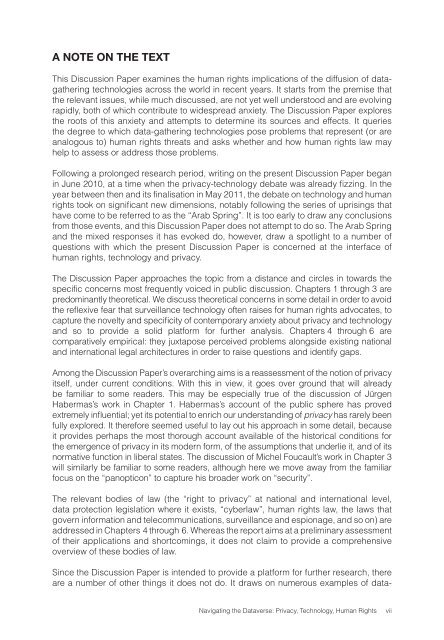Navigating the Dataverse: Privacy, Technology ... - The ICHRP
Navigating the Dataverse: Privacy, Technology ... - The ICHRP
Navigating the Dataverse: Privacy, Technology ... - The ICHRP
Create successful ePaper yourself
Turn your PDF publications into a flip-book with our unique Google optimized e-Paper software.
A Note on <strong>the</strong> Text<br />
This Discussion Paper examines <strong>the</strong> human rights implications of <strong>the</strong> diffusion of dataga<strong>the</strong>ring<br />
technologies across <strong>the</strong> world in recent years. It starts from <strong>the</strong> premise that<br />
<strong>the</strong> relevant issues, while much discussed, are not yet well understood and are evolving<br />
rapidly, both of which contribute to widespread anxiety. <strong>The</strong> Discussion Paper explores<br />
<strong>the</strong> roots of this anxiety and attempts to determine its sources and effects. It queries<br />
<strong>the</strong> degree to which data-ga<strong>the</strong>ring technologies pose problems that represent (or are<br />
analogous to) human rights threats and asks whe<strong>the</strong>r and how human rights law may<br />
help to assess or address those problems.<br />
Following a prolonged research period, writing on <strong>the</strong> present Discussion Paper began<br />
in June 2010, at a time when <strong>the</strong> privacy-technology debate was already fizzing. In <strong>the</strong><br />
year between <strong>the</strong>n and its finalisation in May 2011, <strong>the</strong> debate on technology and human<br />
rights took on significant new dimensions, notably following <strong>the</strong> series of uprisings that<br />
have come to be referred to as <strong>the</strong> “Arab Spring”. It is too early to draw any conclusions<br />
from those events, and this Discussion Paper does not attempt to do so. <strong>The</strong> Arab Spring<br />
and <strong>the</strong> mixed responses it has evoked do, however, draw a spotlight to a number of<br />
questions with which <strong>the</strong> present Discussion Paper is concerned at <strong>the</strong> interface of<br />
human rights, technology and privacy.<br />
<strong>The</strong> Discussion Paper approaches <strong>the</strong> topic from a distance and circles in towards <strong>the</strong><br />
specific concerns most frequently voiced in public discussion. Chapters 1 through 3 are<br />
predominantly <strong>the</strong>oretical. We discuss <strong>the</strong>oretical concerns in some detail in order to avoid<br />
<strong>the</strong> reflexive fear that surveillance technology often raises for human rights advocates, to<br />
capture <strong>the</strong> novelty and specificity of contemporary anxiety about privacy and technology<br />
and so to provide a solid platform for fur<strong>the</strong>r analysis. Chapters 4 through 6 are<br />
comparatively empirical: <strong>the</strong>y juxtapose perceived problems alongside existing national<br />
and international legal architectures in order to raise questions and identify gaps.<br />
Among <strong>the</strong> Discussion Paper’s overarching aims is a reassessment of <strong>the</strong> notion of privacy<br />
itself, under current conditions. With this in view, it goes over ground that will already<br />
be familiar to some readers. This may be especially true of <strong>the</strong> discussion of Jürgen<br />
Habermas’s work in Chapter 1. Habermas’s account of <strong>the</strong> public sphere has proved<br />
extremely influential; yet its potential to enrich our understanding of privacy has rarely been<br />
fully explored. It <strong>the</strong>refore seemed useful to lay out his approach in some detail, because<br />
it provides perhaps <strong>the</strong> most thorough account available of <strong>the</strong> historical conditions for<br />
<strong>the</strong> emergence of privacy in its modern form, of <strong>the</strong> assumptions that underlie it, and of its<br />
normative function in liberal states. <strong>The</strong> discussion of Michel Foucault’s work in Chapter 3<br />
will similarly be familiar to some readers, although here we move away from <strong>the</strong> familiar<br />
focus on <strong>the</strong> “panopticon” to capture his broader work on “security”.<br />
<strong>The</strong> relevant bodies of law (<strong>the</strong> “right to privacy” at national and international level,<br />
data protection legislation where it exists, “cyberlaw”, human rights law, <strong>the</strong> laws that<br />
govern information and telecommunications, surveillance and espionage, and so on) are<br />
addressed in Chapters 4 through 6. Whereas <strong>the</strong> report aims at a preliminary assessment<br />
of <strong>the</strong>ir applications and shortcomings, it does not claim to provide a comprehensive<br />
overview of <strong>the</strong>se bodies of law.<br />
Since <strong>the</strong> Discussion Paper is intended to provide a platform for fur<strong>the</strong>r research, <strong>the</strong>re<br />
are a number of o<strong>the</strong>r things it does not do. It draws on numerous examples of data-<br />
<strong>Navigating</strong> <strong>the</strong> <strong>Dataverse</strong>: <strong>Privacy</strong>, <strong>Technology</strong>, Human Rights vii
















